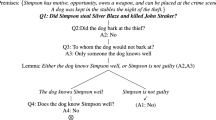Conclusion
A glimpse of the new application of Buddhist logic in the seventeenth century leads us to reflect about our approach to logic in a given religious tradition: Should we isolate a logical system from the very context that has given rise to the genesis and development of such an intellectual apparatus? Methodologically, we do have the legitimate right to approach Buddhist logic from a purely logical point of view. However, when we study the actual use of Buddhist logic in the seventeenth-century anti-Christian polemic, an analysis of its intentional application allows us to conclude that Buddhist logic in the context of controversy is primarily apologetic. Therefore, with a methodological concern, I suggest that philosophers and logicians should reconsider the apologetic nature of logic in any given religious tradition.
Similar content being viewed by others
Abbreviations
- SCPXJ:
-
Shengchao poxieji, 8 vols. Ed. by XupU Changzhi, 1639; reprinted in Japan, 1855–1856
- T:
-
Taishō shinshō daizōkyō, 100 vols. Edited by Takakusu Junjirō et al. Tokyo: Daizō Shuppan, 1924–32
- Z:
-
Shinsan dai Nihon zokuzōkyō, 90 vols. Tokyo: Kokusho Kankōkai, 1975–1989; originally published asDainihon zokuzōkyō, 750 vols. Kyoto: Zōkyō Shoin, 1905–12.
References
Bhatt, S. R. and Anu Mehrotra. 2000.Buddhist Epistemology. Westport, Connecticut and London: Greenwood Press.
d’Elia, Pasquale M. S. J., ed. 1942–49.Fonti Ricciane. Rome: Libreria dello Stato.
Dudink, Adrian. 1994. “Review of Iso Kern’sBuddhistische Kritik am Christentum im China des 17. Jahrhunderts. Texte von Yu Shunxi (?-1621), Zhuhong (1535–1615), Yuanwu(1566–1642), Tongrong (1593–1679), Xingyuan (1611–1662), Zhixu (1599–1655).”T’oung Pao 80. 4–5: 400–420.
Frankenhauser, Uwe. 1996.Die Einführung der Buddhistischen Logik in China. Wiesbaden: Harrassowitz.
Gernet, Jacques. 1985.China and the Christian Impact: A Conflict of Cultures. Cambridge and New York: Cambridge University Press.
Gregory, Peter. 1995.Inquiry into The Origin of Humanity: An Annotated Translation of Tsung-mi’s Yüan Jen Lun with a Modern Commentary. Honolulu: University of Hawaii Press.
Inoue Enryō. 1897.The philosophy of the rthikas (Gedōtetsugaku). Tokyo: Tetsugaku-kan.
Jackson, Roger R. 1999. “Atheology and Buddhalogy in Dharmakīrti’sPramānavārttika.”Faith and Philosophy 16. 4: 472–505.
Keenan, John. 1994.How Master Mou Removes our Doubts: A Reader-Response Study and Translation of the Mou-tzu Li-huo Lun. Albany: SUNY Press.
Kern, Iso. 1984/85. “Matteo Riccis verhältins zum buddhismus.”Monumenta Serica 36: 65–126.
—. 1992.Buddhistische Kritik am Christentum im China des 17. Jahrhunderts. Texte von Yu Shunxi (?-1621), Zhuhong (1535–1615), Yuanwu(1566–1642), Tongrong (1593–1679), Xingyuan (1611–1662), Zhixu (1599–1655). Frankfurt: Peter Lang.
Kohn, Livia 1995.Laughing at the Too: Debates among Buddhists and Taoists in Medieval China. Princeton: Princeton University Press.
Lancashire, Douglas. 1969. “Anti-Christian Polemics in 17th Century China.”Church History 38. 2: 218–241.
—. 1976a. “Buddhist Reaction to Christianity in Late Ming China.”Journal of the Oriental Society of Australia 6. 1–2: 81–103.
—. 1976b. “Chinese Reactions to the Work of Matteo Ricci (1552-1610).”Asian Culture Quarterly 4:106–116.
Mochizuki Shinkō. 1954.Bukkyō Daijiten (Mochizuki Dictionary of Buddhism), vol. 1. Tokyo: Sekai seiten kankō kyōkai.
Mungello, David. 1989.Curious Land: Jesuit Accommodation and the Origins of Sinology. Honolulu: University of Hawaii.
—. 1994.The Forgotten Christians of Hangzhou. Honolulu: University of Hawaii Press.
Nobumi Iyanaga. 1929. “Daijizaiten (Maheśvara).” InHōbōgirin, ed. by Paul Demiéville. Tokyo: Maison franco-japonaise. VI: 713–765.
Perdue, Daniel Elmo. 1992.Debate In Tibetan Buddhism. Ithaca: Snow Lion Publications.
Ricci, Matteo. 1985.The True Meaning of the Lord of Heaven. Trans. by Douglas Lancashire and Peter Hu Kuo-chen. Taipei, Paris, & Hong Kong: Ricci Institute.
Spence, Jonathan. 1984.The Memory Palace of Matteo Ricci. New York: Viking Penguin.
Standaert, Nicolas. 1988.Yang Tingyun, Confucian and Christian in Late Ming China, His Life and Thought. Leiden: E. J. Brill.
—. 1995.The Fascinating God, A Challenge for Modern Chinese Theology Raised by a Text on the Name of God Written by a 17th Century Chinese Student of Theology. Rome: Pontifical Gregorian University Press.
Stcherbatsky, Th. 1993.Buddhist Logic, vol. 1 and 2. Delhi: Motilal Banarsidass.
Tillemans, Tom, J.F. 1999. “On Parārthānumāna, Theses and Syllogisms.” In hisScripture, Logic, Languages: Essays on Dharmakīrti and his Tibetan Successors. Boston: Wisdom Publications.
Wu, Jiang. 2002. “Orthodoxy, Controversy and the Transformation of Chan Buddhism in Seventeenth-century China.” Ph.D. diss., Harvard University.
Xia, Guiqi, ed. 1996.An Anthology of Writings Exposing Heterodoxy. Hong Kong: Alliance Bible Seminary/China Alliance Press.
Xingyun, ed. 1989.Foguang Buddhist Dictionary. Gaoxiong: Foguang Chubanshe.
Zhang, Shengyan. 1975.A Study of Chinese Buddhism in Late Ming Period. Tokyo: Sankibo Busshorin.
Zhang, Zhiqiang. 1997. “The Mind-Only School and the Study of the Mind-Only School in the Late Ming Period.” Ph.D. Diss., Beijing University (Reprinted inStudy of Chinese Buddhism. Taibei, 2000).
Zürcher, Erik, et. al., ed., 1991.Bibliography on the Jesuit Mission in China, Ca. 1580–1680. Leiden University: Center for Non-Western Studies.
Author information
Authors and Affiliations
Corresponding author
Rights and permissions
About this article
Cite this article
Wu, J. Buddhist logic and apologetics in 17th century China: An analysis of the use of Buddhist syllogisms in an anti-Christian polemic. Dao 2, 273–289 (2003). https://doi.org/10.1007/BF02857199
Issue Date:
DOI: https://doi.org/10.1007/BF02857199




